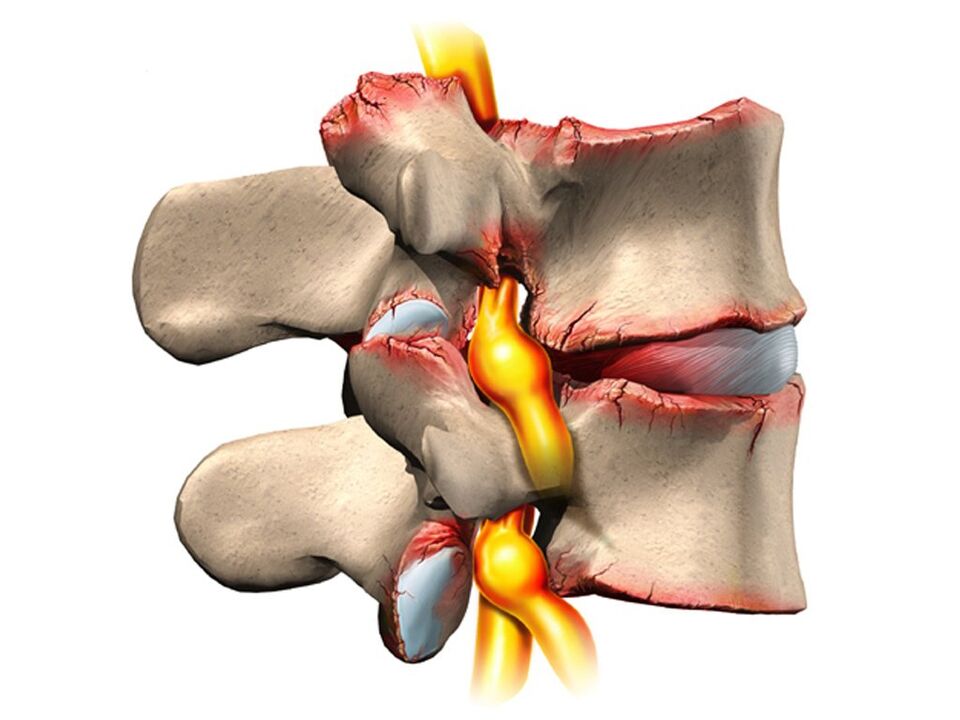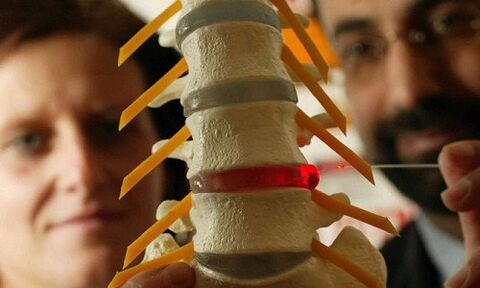
The term osteochondrosis itself is derived from two words: osteo - bone and chondrue - cartilage. Simply put, it is the ossification of cartilage. Although this interpretation is fundamentally wrong. Some go further in their delusions, and are convinced that osteochondrosis is the deposition of salt in the joints. Moreover, table salt is reportedly consumed in large quantities for food.
Pathogenesis
In reality, everything happens a little differently. And stronger. And kitchen salt, if it has any role in the development of osteochondrosis, is very indirect. Osteochondrosis is based on degeneration and degeneration of articular cartilage. This is not an independent disease, but a pathological process that can be observed almost everywhere where there is connective cartilage tissue.
However, osteochondrosis in a large number of cases affects the spine. Why is that? The fact is that there are a kind of pads between the vertebrae - intervertebral (intervertebral) discs. The physiological role of these discs is to cushion and protect the vertebral bodies from premature wear due to mechanical stress. The disc consists of the inner flowing nucleus of the pulposus surrounded by the annulus fibrosus and the upper and lower end plates.
The disc is subjected to enormous mechanical stress, which leads to permanent damage to its structures at the cellular level. In humans, these processes are too pronounced - it is our compensation for upright walking. In order to prevent the disk from being completely "erased", it must be constantly regenerated. The balance of the process of damage and regeneration determines the normal structure of the intervertebral disc. Another interesting detail is that the supply of intervertebral discs with blood and nutrients does not take place through blood vessels, which healed in childhood, but diffusely, from the bone tissue of the vertebral body. Again, paying for the ability to move on two limbs, not on four.
Therefore, intervertebral discs are easily injured in anatomical and physiological terms. Every negative process in the body leads to an imbalance in the balance of damage and regeneration, and to the development of dystrophy and degeneration of the discs. A structurally defective disk is no longer able to withstand the corresponding mechanical stress. Under excessive pressure of the upper vertebrae, the discs move in different directions, usually to the side and back. This process is called a disc herniation.
The bone tissue of the vertebrae, which has lost cartilage, is also subjected to mechanical wear. Due to the constant trauma on the anterior marginal surface of the vertebral body, pathological bone growths - osteophytes - occur. Spondylosis develops. Due to degeneration and displacement of the disc, there is a reduction of the intervertebral spaces, narrowing of the spinal canal, penetration of the roots of the spinal nerves in the so-called. foraminal openings.
Causes
The causes and etiological factors of osteochondrosis are different. They can be local, ie due to the pathology of the spine itself, as well as general disorders at the level of the organism. The cause of osteochondrosis can be considered any pathology that leads to a violation of the structure of the spine or metabolic disorders. In this regard, there are:
- Changes in the configuration of the spine (scoliosis, pathological lordosis or kyphosis).
- Other defects of the musculoskeletal system are flat feet, narrow shoulder girdle, anomalies in the structure of the pelvis.
- Spinal cord injury.
- Weak immunity.
- Metabolic disorders - osteoporosis, obesity, diabetes mellitus, thyroid disease.
- Diseases of the cardiovascular system - atherosclerosis, hypertension.
- Digestive disorders that lead to insufficient absorption of nutrients from the gastrointestinal tract.
- Heredity.
It should be noted that the above pathological conditions do not necessarily lead to osteochondrosis. This requires constant exposure to certain predisposing factors - hypothermia, malnutrition, sedentary lifestyle or, conversely, excessive physical exertion.
Symptoms
Osteochondrosis is in itself an asymptomatic process. At the same time, the signs of intervertebral disc degeneration are varied. How that? The fact is that the clinical manifestations of osteochondrosis are based on its complications - disc herniation, spondylosis, sciatica, narrowing of the spinal canal.
Moreover, the clinic is highly variable depending on the dominant localization of the process in the cervical, thoracic, or lumbosacral spine. The last part is most often affected, because the lower back is the one that takes over the maximum physical activity. Signs of osteochondrosis of the lumbosacral region:
- Pain (lumbonia, lumbago, sciatica).
- Restriction of movement in the lower back and lower extremities (intermittent claudication).
- Sensitivity disorders of the paresthesia type occur here - numbness, tingling, crawling.
- Pathological lumbar muscle tension.
- In the absence of treatment, disorders of pelvic organ function.
Cervical osteochondrosis is observed somewhat less frequently than lumbosacral. However, this pathology is also quite common. In addition to the typical signs of pain (cervicalgia), decreased sensitivity and movement in the upper extremities, cervical osteochondrosis due to impaired blood flow to the brain has its own characteristics. These characteristics are manifested:
- Insomnia.
- Headache, dizziness.
- Periodic nausea.
- General weakness, rapid fatigue.
- Blood pressure fluctuations.
- Occasional toothache.
- Behavioral reactions in the form of crying, irritability.
The thoracic region with osteochondrosis is affected relatively rarely. Patients in this case are people who are forced to sit in a fixed uncomfortable position by profession - students, schoolchildren, programmers, office workers. The symptoms of osteochondrosis in this case will be as follows:
- Chest pain and paresthesias.
- dyspnea.
- Feeling of heartbeat.
- Restriction of movement in the thoracic spine.

Diagnosis
It is clear from everything that osteochondrosis is a chameleon disease. Due to the similarity of the signs, it is easy to confuse it with cerebrovascular infarction, hypertension, myocardial infarction, angina pectoris, neurotic disorders. Therefore, in order to make a correct diagnosis, a comprehensive complex diagnosis is necessary in order to correctly determine the symptoms and treatment of osteochondrosis.
This diagnosis, in addition to the traditional examination and clarification of the patient's complaints, should include a medical examination and special research methods. These methods include X-rays of the spine, ultrasound of internal organs. Recently, computed tomography and magnetic resonance imaging have been used successfully to diagnose osteochondrosis.
Treatment
Therapeutic tactics for osteochondrosis include the use of:
- Medications.
- Massage.
- Physiotherapy procedures.
- Physiotherapy (exercise therapy).
- Manual therapy.
- Acupuncture.
Osteochondrosis medications are mainly aimed at relieving pain and eliminating inflammatory processes in the nerve roots. In various combinations, these drugs are widely used in the form of ointments, injections, tablets for the treatment of osteochondrosis. It should not be forgotten that these drugs have a negative effect on the liver, stomach and intestines. This can worsen metabolic disorders in osteochondrosis. Local anesthetics relieve the pain of blockage well. True, the effect of these funds is short-lived and in no way affects the course of osteochondrosis as a whole.
Metabolic processes at the local and body level can be improved with the help of drugs such as chondroprotectors, immunostimulants, vitamins with minerals. Chondroprotectors are used in tablets, ointments and ampoules. Among the strengthening agents, vitamins C, group B, are used in combination with minerals. In that sense, calcium preparations are the most desirable. Indeed, contrary to some misconceptions, the basis of osteochondrosis is not an excess, but only a lack of calcium.
After successful alleviation of exacerbation, physiotherapy procedures, massage, and exercise therapy were presented. Calcium electrophoresis, phonophoresis with hydrocortisone, amplipulse, paraffin therapy are used as physical procedures. All these measures are aimed at relieving pain and inflammation in the nerve roots, ligaments and muscles. Massage for osteochondrosis is performed according to the generally accepted method. The massage zone is selected depending on the localization of osteochondrosis. Expansion of the range of motion is achieved with the help of exercise therapy. Initially, in the exacerbation phase, there are virtually no dynamic loads. The patient is constantly in the optimal position. At this time, it is desirable to wear immobilizers - lumbar corset, Shant's neck collar. As the deterioration subsides, the volume and duration of movement during exercise therapy increase.
Recently, non-traditional methods of treatment have been used in the treatment of osteochondrosis - acupuncture, manual therapy, osteopathy. Acupuncture is an action on special biologically active points that are located along the spine, on the ear shells, on the hands and feet. With manual therapy, the normal position of the vertebrae and intervertebral discs is restored by the manual action of the specialist's hands. And during osteopathy, the structural integrity of the musculoskeletal system is ensured by special techniques. In the absence of the effect of conservative measures for the treatment of osteochondrosis, persistent pain, complications, surgery is indicated. The pathologically displaced disc is removed. Microdiscectomy - endoscopic removal of the displaced disc - is currently being performed for this purpose.















































